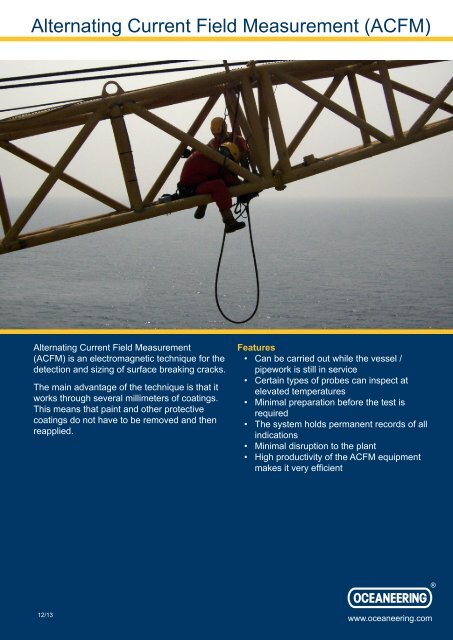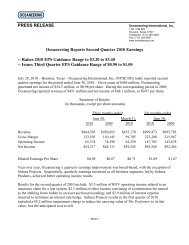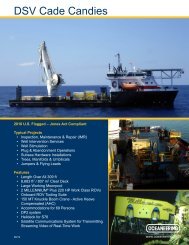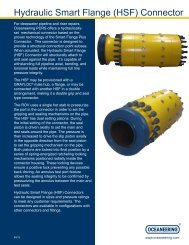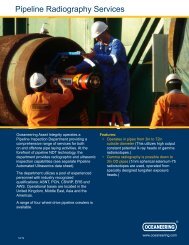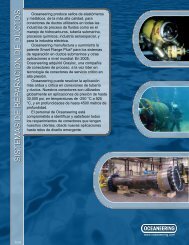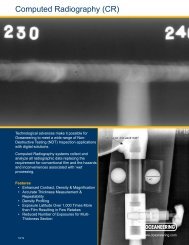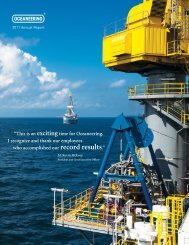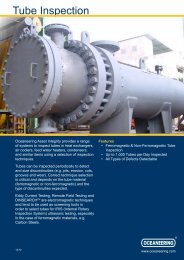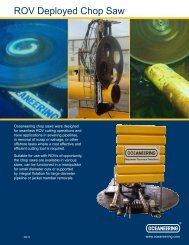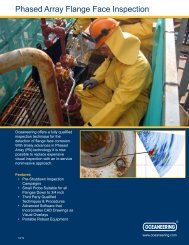alternating current field measurement (acfm) - Oceaneering
alternating current field measurement (acfm) - Oceaneering
alternating current field measurement (acfm) - Oceaneering
Create successful ePaper yourself
Turn your PDF publications into a flip-book with our unique Google optimized e-Paper software.
Alternating Current Field Measurement (ACFM)Alternating Current Field Measurement(ACFM) is an electromagnetic technique for thedetection and sizing of surface breaking cracks.The main advantage of the technique is that itworks through several millimeters of coatings.This means that paint and other protectivecoatings do not have to be removed and thenreapplied.Features• Can be carried out while the vessel /pipework is still in service• Certain types of probes can inspect atelevated temperatures• Minimal preparation before the test isrequired• The system holds permanent records of allindications• Minimal disruption to the plant• High productivity of the ACFM equipmentmakes it very efficient12/13www.oceaneering.com
Alternating Current Field Measurement (ACFM)TechniqueThe ACFM Amigo U19 Crack Microgauge usesa probe to induce a uniform <strong>alternating</strong> <strong>current</strong>in the area under test and detects the resulting<strong>current</strong> flow near to the surface. The <strong>current</strong> isundisturbed if the area is free of surface breakingcracks. A surface breaking crack will redirect the<strong>current</strong> around the ends and faces of the crack.The ACFM instrument measures thesedisturbances in the <strong>field</strong> and uses mathematicalalgorithms to estimate the crack depth.Capabilities• No need to remove paint or thin coatings• Detects and sizes both crack length & depth• Offline analysis of data• Provides a permanent record of indications• Ongoing monitoring capability• No chemical agents & therefore requires noCOSHH assessment• Provides an immediate evaluation of theweld area• Quick & efficient method of inspection• High temperature capability• Works equally well on plain material orwelds• Will inspect ferritic & non-ferretic materialsApplications• Structural weld inspection• Offshore cranes• Storage tanks floor & roof ‘lap’ joints• Storage tank annular welds internal &external• Vessel nozzlesLimitations• Not recommended for short sections orsmall items• Locations of weld repairs & grinding cancause spurious indications• Crack dimensions need to be greater than5-10mm long and 0.5mm deep• Multiple defects reduce the ability to depthsize cracks<strong>Oceaneering</strong> International, Inc. | Asset Integrity | 11911 FM 529 | Houston, TX 77041email: Asset-Integrity@oceaneering.com | oceaneering.com/asset-integrityOCEANEERING ® is a registered trademark of <strong>Oceaneering</strong> International, Inc.


